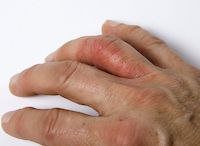News
Article
Patients With PsA and Blue-Collar Jobs Have High Rates of Work Disability
Author(s):
Types of occupation did not significantly affect response to treatment.
Credit: Adobe Stock

People with psoriatic arthritis (PsA) and blue-collar jobs (BCol) with manual labor have increased rates of work disability compared with white-collar (WCol) workers with sedentary occupations while treatment responses did not significantly differ by occupation type.1
“Because BCol workers often face higher levels of biomechanical stress on their joints and entheses, this could trigger or worsen inflammation in these areas, leading to higher disease activity or poorer response to medication among PsA patients who work in physically demanding occupations,” lead investigator Nina Colla, Department of Rheumatology, University Hospital Zurich, University of Zurich Winterthur, Switzerland, and colleagues wrote.1 “Despite these hypotheses, the direct implication of work-related physical demands in PsA patients remains unexplored. It remains unclear whether PsA patients with high physical workloads experience increased disease activity or diminished treatment response.”
Colla and colleagues analyzed data from patients with PsA from the Swiss Clinical Quality Management in Rheumatic Diseases (SCQM) registry from January 2000 to September 2020 classified as BCol or WCol and assessed at the initiation of a biologic or targeted synthetic disease-modifying anti-rheumatic drug (b-/tsDMARD). They compared baseline characteristics at treatment start and the Disease Activity Score 28 using C-reactive protein (DAS28-CRP) for the 1-year remission and investigated treatment retention using Kaplan–Meier curves and Cox regression analysis.1
The investigators found that of 564 patients, 29% were BCol and 71% were WCol workers, with similar baseline disease activity. BCol workers were predominantly male (79.8%) and had a higher rate of work disabilityat baseline (84.0%) than WCol workers (27.9%; P <.01). The analysis also included 174 treatment courses in 165 patients with PsA.1
They found that occupation did not significantly influence achievement of DAS28-CRP remission at 1 year. Kaplan–Meier analysis (n = 671) did indicate longer retention for BCol workers, however, this did not remain significant after adjusted Cox regression analysis.1
“In conclusion, this study suggests that physically demanding occupations correlate with increased rates of work disability among PsA patients, particularly men. Further research is needed to fully understand the impact of physical workload on disease burden and to develop effective interventions for preventing long-term work disability among PsA patients,” Colla and colleagues wrote.1
Other recent research with quality of life in patients with PsA has found that patients who achieve clinical disease control are more likely to see significant improvements in patient-reported outcomes (PROs) and quality of life measures.2
Investigators analyzed data from 1069 patients in the SELECT-PsA 1 trial and 317 patients in the SELECT-PsA 2 trial were analyzed. Responders were defined as those who achieved MDA or VLDA, and PASDAS, DAPSA, and RAPID3 LDA or remission. Disease control was obtained by similar proportions of patients in the upadacitinib15 mg QD cohort, placebo to upadacitinib 15 mg QD cohort, and adalimumab 40 mg EOW cohort.2
In both studies, responders at week 104 demonstrated more marked changes from baseline and achieved normative values in PROs compared with non-responders (P <.0001). Additionally, more responders obtained minimal clinically important differences among PROs compared with non-responders. Those who achieved MDA or VLDA were more likely to achieve PASDAS, DAPSA, and RAPID3 LDA or remission (P <.0001) for upadacitinib15 mg QD and for pooled treatment arms.2





